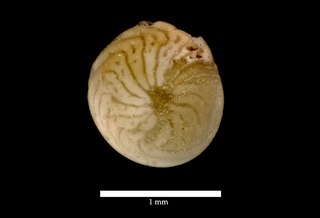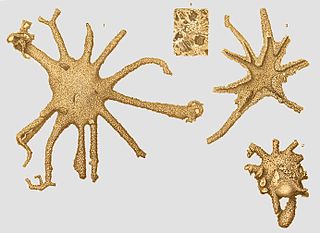
The Globigerinina is a suborder of foraminiferans that are found as marine plankton. They produce hyaline calcareous tests, and are known as fossils from the Jurassic period onwards. The group has included more than 100 genera and over 400 species, of which about 30 species are extant. One of the most important genera is Globigerina; vast areas of the ocean floor are covered with Globigerina ooze, dominated by the shells of planktonic forms.

The Fusulinida is an extinct order within the Foraminifera in which the tests are traditionally considered to have been composed of microgranular calcite. Like all forams, they were single-celled organisms. In advanced forms the test wall was differentiated into two or more layers. Loeblich and Tappan, 1988, gives a range from the Lower Silurian to the Upper Permian, with the fusulinid foraminifera going extinct with the Permian–Triassic extinction event. While the latter is true, a more supported projected timespan is from the Mid-Carboniferous period.

The Rotaliida are an order of Foraminifera, characterized by multilocular tests (shells) composed of bilamellar perforate hyaline lamellar calcite that may be optically radial or granular.
Carterina is a genus in the family Trochamminidae, composing its own subfamily Carterininae. The genus is described from specimens gathered during the Challenger expedition's circumnavigation of the Earth from 1872-1876.

The Asterigerinacea is a superfamily of Foraminifera included in the order Rotaliida, proposed by Loeblich and Tappan in 1988.
Hantkeninoidea is a superfamily of foraminifera with planispiral or enrolled biserial tests, found in marine sediments of Paleocene to Miocene age, in which chambers vary from globular to elongate and the primary aperture is equatorial in position. It contains one family, the Hantkeninidae.
The Fusulinidae is a family of fusulinacean foraminifera from the upper Carboniferous to the Upper Permian (Guadalupian), tests of which are fusiform to subcylindrical with walls of two to four layers. Are planispirally coiled throughout or with early whorls at a distinct angle to the later plane of coiling. Septa, flat to well fluted; tunnel, single; chomata variable in development.

Cibicides is a genus of cosmopolitan benthic foraminifera known from at least as far back as the Paleocene that extends down to the present.
Discorbis is a genus of benthic Foraminifera, that made its first appearance during the Eocene. Its present distribution is cosmopolitan.
Astrononion is a genus of foraminifera in the family Nonionidae, characterized by an evolute planispiral test with radially stellate structures partly covering the sutures on either side. The test is free, bilaterally symmetrical; periphery broadly rounded; chambers distinct, separated by depressed radial sutures, increasing gradually in size, and usually inflated; aperture a low arched opening at the base of the face of the test. The wall is of finely perforate monolamellar granular calcite.
The Globoroatioidea constitutes a superfamily of Cenozoic plantonic foraminifera. It is part of the suborder Globigerinina. Globoroatioidea have trochospiral tests with rounded to carinate peripheries, the walls of which are of finely lamellar, perforate, of optically radial calcite, with an inner organic lining. The surface of these tests is smooth, lacking spines, but may be covered with pustules or pitted, and may have one or more large pores at the center. There is a single primary aperture that may be bordered by an imperforate lip, as well as possible supplementary apertures.
Sigmoilina is a miliolid genus, referring to the foraminiferal order Miliolida, characterized by an assymmetricall biconvex test formed by strongly overlapping chambers, one-half coil in length, that form a sigmoid (S-shaped) curve in cross section. The strongly overlapping chambers obliterate earlier ones from view resulting in the compressed biloculine appearance, differing from the squat, depressed biloculine form of Pyrgo and Biloculina. The test, as for all Miliolida, is porcelaneous and imperphorate, the terminal aperture, with tooth, the only point of egress and ingress for the animal.

Astrorhizana are a subclass of foraminifera characterized by simple tests composed of agglutinated material that can be irregular, spheroidal, or tubular and straight, branching or enrolled. Tests are non septate and consist of a single chamber following the proloculus. These are the Ammodiscacea of the Textulariina in the Treatise Part C, that range from the Cambrian to Recent.
Lagynana is a subclass of foraminifera which comprises Astrorhizata with membranous or pseudochitinous tests that may have ferruginous encrustations or more rarely small quantities of agglutinated material. The Lagynacea Schultze, 1854, of the Allogriomiina, is fairly equivalent.
Alfred R. Loeblich Jr was an American micropaleontologist. He was married to Helen Niña Tappan Loeblich and the two co-authored a number of important works on the Foraminifera and related organisms.
Meandropsinidae is an extinct family of miliolid forams found in Upper Cretaceous (Cenomanian) to middle Paleocene marine sediments.
Spirocyclina is a genus of large forams, with a flat test as much as 10mm in diameter. Coiling is planispiral to slightly asymmetric and mostly involute, some becoming uncoiled with a straight final stage. The final whorl, or stage, has about 25 strongly arcuate chambers. Composition is of agglutinated matter, the outer layer of the wall imperforate. Chambers are subdivided into secondary chamberlets by internal structures. The aperture consists of a double row of pores on the apertural face. Anchispirocyclina and Martiguesia are among related genera.
Haurania is a genus of elongated, finely agglutinated benthic foraminifera included in the Spirocyclinidae. The test is free, starting with a brief planispiral coil followed by a straight uncoiled stage. The exterior is imperforate, the interior divided by radial septula or beams, perpendicular to the septa and outer wall. The aperture is cribrate, a series of openings on the terminal face.
Martiguesia is a genus of agglutinated benthic forams from the Upper Cretaceous (Santonian) of France. The test is free, the early stage planispirally coiled, becoming nearly straight during later growth. The agglutinated wall is externally imperforate, the interior with a coarse alveolar network. Chambers are subdivided and almost completely filled by irregular radial pillars. The aperture, cribrate.
Pseudospirocyclina is a genus of large planispirally coiled agglutinated benthic forams with a complex interior known from the upper Jurassic (Kimmeridgian) of Portugal and Morocco.






